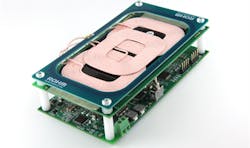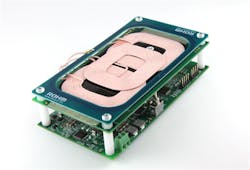Rohm Combines Automotive Wireless Charging with NFC
Rohm has announced development of an automotive wireless-charging solution with integrated near-field communication (NFC). It merges together Rohm’s automotive-grade (AEC-Q100 qualified) wireless power transmission control IC (BD57121MUF-M) with STMicroelectronics' NFC Reader IC (ST25R3914) and 8-bit microcontroller (STM8A series).
In addition to being compliant to WPC's Qi standard supporting EPP (Extend Power Profile), which enables the charger to supply up to 15 W of power, the multi-coil design is said to enable a wide charging area (2.7X greater charging range versus single coil configurations). This means that consumers needn’t worry about exactly aligning their smartphones to the provided charging area to be able to charge wirelessly.
Qi wireless charging has been adopted by the European Automotive Standards Group (CE4A) as the charging standard in vehicles. By 2025, it’s predicted that most cars will be equipped with Qi-based wireless chargers.
NFC provides user authentication to allow for Bluetooth/Wi-Fi communication with infotainment units, door lock/unlock systems, and engine starting. NFC also enables customized vehicle settings for multiple drivers, such as seat and mirror positioning, infotainment pre-sets, and navigation destination pre-sets. In operation, a smartphone is placed on the charging pad to automatically initiate screen sharing with the infotainment and navigation system.
Previously, when connecting smartphones to infotainment systems, it was necessary to perform manual pairing for each device. However, by combining Qi wireless charging with NFC communications, Rohm has made it possible to not only charge mobile devices such as smartphones, but also perform Bluetooth or Wi-Fi pairing simultaneously through NFC authentication.
Rohm’s multi-coil design enables a wider charging area. (Source: Rohm)
The ST25R3914/3915 automotive-grade NFC reader ICs are compatible with ISO14443A/B, ISO15693, FeliCa, and ISO18092 (NFCIP-1) Active P2P. They incorporate an analog front end featuring what’s claimed to be best-in-class receiver sensitivity, delivering foreign-object detection performance in vehicle center consoles. Per the Qi standard, a foreign object detection function for detecting metallic objects is included. This prevents deformation or damage from occurring due to excessive heat generation in the event a metallic object is placed between the transmitter and receiver.
The ST25R3914 includes ST’s proprietary Automatic Antenna Tuning function. It adapts to surrounding environment changes to minimize the effects from metallic objects near the reader antenna, such as keys or coins placed on the center console. In addition, MISRA-C: 2012-compliant RF middleware is available, which helps customers reduce their software-development effort.
The STM8A automotive 8-bit MCU series comes in a variety of packages and memory sizes. Devices with embedded data EEPROMs are also offered, including CAN-equipped models featuring an extended operating temperature range guaranteed up to 150°C, making them well-suited for a variety of automotive applications.

